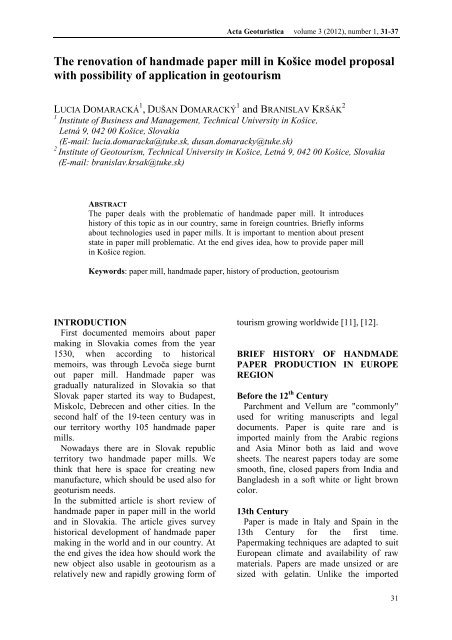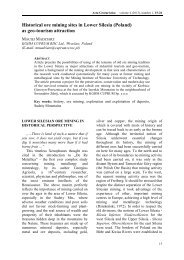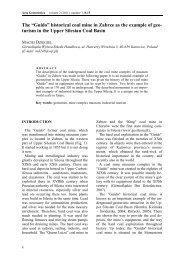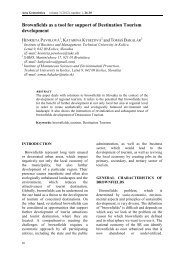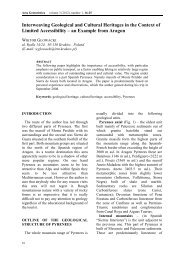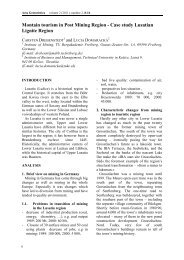The renovation of handmade paper mill in Košice ... - Acta Geoturistica
The renovation of handmade paper mill in Košice ... - Acta Geoturistica
The renovation of handmade paper mill in Košice ... - Acta Geoturistica
Create successful ePaper yourself
Turn your PDF publications into a flip-book with our unique Google optimized e-Paper software.
<strong>Acta</strong> <strong>Geoturistica</strong> volume 3 (2012), number 1, 31-37<br />
<strong>The</strong> <strong>renovation</strong> <strong>of</strong> <strong>handmade</strong> <strong>paper</strong> <strong>mill</strong> <strong>in</strong> Košice model proposal<br />
with possibility <strong>of</strong> application <strong>in</strong> geotourism<br />
LUCIA DOMARACKÁ 1 , DUŠAN DOMARACKÝ 1 and BRANISLAV KRŠÁK 2<br />
1 Institute <strong>of</strong> Bus<strong>in</strong>ess and Management, Technical University <strong>in</strong> Košice,<br />
Letná 9, 042 00 Košice, Slovakia<br />
(E-mail: lucia.domaracka@tuke.sk, dusan.domaracky@tuke.sk)<br />
2<br />
Institute <strong>of</strong> Geotourism, Technical University <strong>in</strong> Košice, Letná 9, 042 00 Košice, Slovakia<br />
(E-mail: branislav.krsak@tuke.sk)<br />
ABSTRACT<br />
<strong>The</strong> <strong>paper</strong> deals with the problematic <strong>of</strong> <strong>handmade</strong> <strong>paper</strong> <strong>mill</strong>. It <strong>in</strong>troduces<br />
history <strong>of</strong> this topic as <strong>in</strong> our country, same <strong>in</strong> foreign countries. Briefly <strong>in</strong>forms<br />
about technologies used <strong>in</strong> <strong>paper</strong> <strong>mill</strong>s. It is important to mention about present<br />
state <strong>in</strong> <strong>paper</strong> <strong>mill</strong> problematic. At the end gives idea, how to provide <strong>paper</strong> <strong>mill</strong><br />
<strong>in</strong> Košice region.<br />
Keywords: <strong>paper</strong> <strong>mill</strong>, <strong>handmade</strong> <strong>paper</strong>, history <strong>of</strong> production, geotourism<br />
INTRODUCTION<br />
First documented memoirs about <strong>paper</strong><br />
mak<strong>in</strong>g <strong>in</strong> Slovakia comes from the year<br />
1530, when accord<strong>in</strong>g to historical<br />
memoirs, was through Levoča siege burnt<br />
out <strong>paper</strong> <strong>mill</strong>. Handmade <strong>paper</strong> was<br />
gradually naturalized <strong>in</strong> Slovakia so that<br />
Slovak <strong>paper</strong> started its way to Budapest,<br />
Miskolc, Debrecen and other cities. In the<br />
second half <strong>of</strong> the 19-teen century was <strong>in</strong><br />
our territory worthy 105 <strong>handmade</strong> <strong>paper</strong><br />
<strong>mill</strong>s.<br />
Nowadays there are <strong>in</strong> Slovak republic<br />
territory two <strong>handmade</strong> <strong>paper</strong> <strong>mill</strong>s. We<br />
th<strong>in</strong>k that here is space for creat<strong>in</strong>g new<br />
manufacture, which should be used also for<br />
geoturism needs.<br />
In the submitted article is short review <strong>of</strong><br />
<strong>handmade</strong> <strong>paper</strong> <strong>in</strong> <strong>paper</strong> <strong>mill</strong> <strong>in</strong> the world<br />
and <strong>in</strong> Slovakia. <strong>The</strong> article gives survey<br />
historical development <strong>of</strong> <strong>handmade</strong> <strong>paper</strong><br />
mak<strong>in</strong>g <strong>in</strong> the world and <strong>in</strong> our country. At<br />
the end gives the idea how should work the<br />
new object also usable <strong>in</strong> geotourism as a<br />
relatively new and rapidly grow<strong>in</strong>g form <strong>of</strong><br />
tourism grow<strong>in</strong>g worldwide [11], [12].<br />
BRIEF HISTORY OF HANDMADE<br />
PAPER PRODUCTION IN EUROPE<br />
REGION<br />
Before the 12 th Century<br />
Parchment and Vellum are "commonly"<br />
used for writ<strong>in</strong>g manuscripts and legal<br />
documents. Paper is quite rare and is<br />
imported ma<strong>in</strong>ly from the Arabic regions<br />
and Asia M<strong>in</strong>or both as laid and wove<br />
sheets. <strong>The</strong> nearest <strong>paper</strong>s today are some<br />
smooth, f<strong>in</strong>e, closed <strong>paper</strong>s from India and<br />
Bangladesh <strong>in</strong> a s<strong>of</strong>t white or light brown<br />
color.<br />
13th Century<br />
Paper is made <strong>in</strong> Italy and Spa<strong>in</strong> <strong>in</strong> the<br />
13th Century for the first time.<br />
Papermak<strong>in</strong>g techniques are adapted to suit<br />
European climate and availability <strong>of</strong> raw<br />
materials. Papers are made unsized or are<br />
sized with gelat<strong>in</strong>. Unlike the imported<br />
31
<strong>Acta</strong> <strong>Geoturistica</strong> volume 3 (2012), number 1, 31-37<br />
<strong>paper</strong>s <strong>of</strong> Arabic orig<strong>in</strong> which are<br />
predom<strong>in</strong>antly unsized or sized with starch.<br />
European made <strong>paper</strong>s are laid only. Cha<strong>in</strong><br />
l<strong>in</strong>es are <strong>of</strong> vary<strong>in</strong>g widths and watermarks<br />
are <strong>of</strong> relatively crude construction.<br />
14th Century and 15th Century<br />
Papermak<strong>in</strong>g spreads through Western<br />
Europe. Mills produc<strong>in</strong>g the f<strong>in</strong>er <strong>paper</strong>s<br />
are usually situated near cities and <strong>in</strong> areas<br />
where there is a good supply <strong>of</strong> clean water<br />
and the greater availability <strong>of</strong> f<strong>in</strong>e l<strong>in</strong>en<br />
rags. Coarser and <strong>in</strong>ferior quality <strong>paper</strong>s<br />
were made by <strong>mill</strong>s near ports where old<br />
sails and ropes could be used. Paper <strong>mill</strong>s<br />
<strong>in</strong> the country areas produced, as a rule,<br />
<strong>paper</strong>s <strong>of</strong> rough or <strong>in</strong>termediate quality.<br />
Paper is exported between countries <strong>in</strong><br />
Europe.<br />
Cha<strong>in</strong> l<strong>in</strong>es are still <strong>of</strong> vary<strong>in</strong>g widths but<br />
watermarks beg<strong>in</strong> to be better made<br />
sometimes more complex <strong>in</strong> design.<br />
17th and 18th Centuries<br />
Handmade <strong>paper</strong>mak<strong>in</strong>g comes <strong>of</strong> age<br />
and some <strong>of</strong> the f<strong>in</strong>est <strong>paper</strong>s ever made by<br />
hand are produced. Pulp quality is<br />
improved by the adoption <strong>of</strong> the Hollander<br />
Beater and <strong>paper</strong> moulds <strong>of</strong> superior<br />
construction particularly <strong>in</strong> England.<br />
In the mid 1700's the first wove <strong>paper</strong> <strong>of</strong><br />
European orig<strong>in</strong> is made <strong>in</strong> England.<br />
However it wasn't until just over 30 years<br />
later that wove <strong>paper</strong> was produced <strong>in</strong> any<br />
great quantity. Synthetic bleach began to be<br />
used to correct the color <strong>of</strong> the pulp. Cha<strong>in</strong><br />
l<strong>in</strong>e spac<strong>in</strong>g <strong>in</strong> laid <strong>paper</strong>s becomes more<br />
standardized and watermarks can be highly<br />
decorative.<br />
19th Century<br />
This was a period <strong>of</strong> great change <strong>in</strong> the<br />
<strong>paper</strong>mak<strong>in</strong>g <strong>in</strong>dustry. <strong>The</strong> <strong>in</strong>vention and<br />
adoption <strong>of</strong> the <strong>paper</strong>mak<strong>in</strong>g mach<strong>in</strong>e <strong>in</strong> the<br />
early decades <strong>of</strong> the 1800's brought about a<br />
sharp decl<strong>in</strong>e <strong>in</strong> the number <strong>of</strong> <strong>handmade</strong><br />
<strong>mill</strong>s. Paper cont<strong>in</strong>ues to be made from<br />
l<strong>in</strong>en, hemp and cotton rags until the first<br />
commercially supply <strong>of</strong> wood pulp<br />
becomes available <strong>in</strong> the 1850's. Natural<br />
dyestuffs beg<strong>in</strong> to be replaced by the new<br />
synthetic chemical dyes.<br />
20 th Century<br />
Some <strong>handmade</strong> <strong>mill</strong>s survive by<br />
produc<strong>in</strong>g <strong>paper</strong> for niche markets whilst<br />
other <strong>mill</strong>s survive as work<strong>in</strong>g museums.<br />
Work<strong>in</strong>g knowledge is gradually lost as the<br />
last generation <strong>of</strong> traditionally tra<strong>in</strong>ed full -<br />
time work<strong>in</strong>g <strong>paper</strong>makers lay down their<br />
moulds for the last time.<br />
PAPER MAKING IN SLOVAKIA<br />
FROM HISTORICAL VIEW<br />
Paper production <strong>in</strong> Slovak territory<br />
reached to 14 th century. In this period is<br />
usage <strong>of</strong> <strong>paper</strong> documents more common<br />
although parchment still persist. <strong>The</strong> whole<br />
century is <strong>paper</strong> imported from foreign<br />
countries, ma<strong>in</strong>ly form Italian <strong>paper</strong> <strong>mill</strong>s.<br />
<strong>The</strong> trade from Venezia was not lead<strong>in</strong>g<br />
straight to our country, but was traded<br />
through Wien bus<strong>in</strong>essmen.<br />
In 15 th century is chang<strong>in</strong>g Italian<br />
monopoly situation <strong>in</strong> the whole trade<br />
bus<strong>in</strong>ess under onslaught <strong>of</strong> Turkey what<br />
was reflect<strong>in</strong>g also on <strong>paper</strong> import to<br />
Slovakia region. Import <strong>of</strong> <strong>paper</strong> from Italy<br />
and France is decl<strong>in</strong><strong>in</strong>g and till the end <strong>of</strong><br />
16-teen century stops def<strong>in</strong>itely. To the<br />
Slovak region is started import <strong>of</strong> <strong>paper</strong><br />
from south Germany and Austrian <strong>paper</strong><br />
<strong>mill</strong>s, later from Czech cities, as: Opava,<br />
Jihlava, Benešov and Litovna. This import<br />
persisted till 18 th century [1].<br />
From this po<strong>in</strong>t <strong>of</strong> view results, that<br />
Slovakia was till 18 th century country<br />
depended on <strong>paper</strong> import.<br />
S<strong>in</strong>ce the demand was grow<strong>in</strong>g it was<br />
reason for creation own <strong>paper</strong> <strong>mill</strong>s <strong>in</strong><br />
Slovakia and the dependence on import was<br />
decreas<strong>in</strong>g till it stops def<strong>in</strong>itely. Slovakia<br />
becomes gradually also <strong>paper</strong> exporter,<br />
ma<strong>in</strong>ly to Budapest, Miskolc, Debrecen and<br />
other cities [1].<br />
Handmade <strong>paper</strong> mak<strong>in</strong>g <strong>in</strong> Slovakia<br />
„From creation <strong>of</strong> first <strong>handmade</strong> <strong>paper</strong><br />
32
<strong>Acta</strong> <strong>Geoturistica</strong> volume 3 (2012), number 1, 31-37<br />
<strong>mill</strong> <strong>in</strong> Slovakia till the ext<strong>in</strong>ction <strong>of</strong><br />
<strong>handmade</strong> <strong>paper</strong> mak<strong>in</strong>g till the second half<br />
<strong>of</strong> 19 th century passed over four hundred<br />
years.” [1].<br />
Through this period were existed over one<br />
hundred and five <strong>handmade</strong> <strong>paper</strong> <strong>mill</strong>s.<br />
Like evidence we can see materials and<br />
transparency which were preserved.<br />
Handmade <strong>paper</strong> mak<strong>in</strong>g was spread also <strong>in</strong><br />
eastern Slovakia <strong>in</strong> five counties, like<br />
Abov, Gemer, Šariš, Spiš and Zempl<strong>in</strong><br />
County.<br />
Accord<strong>in</strong>g to historical base only <strong>in</strong> Abov<br />
County used to work completely fifty five<br />
<strong>handmade</strong> <strong>paper</strong> <strong>mill</strong>s, therefore more than<br />
half <strong>of</strong> all <strong>handmade</strong> <strong>paper</strong> <strong>mill</strong>s <strong>in</strong><br />
Slovakia [3].<br />
<strong>The</strong> device <strong>of</strong> <strong>handmade</strong> <strong>paper</strong> <strong>mill</strong>s<br />
<strong>The</strong> base <strong>of</strong> <strong>handmade</strong> <strong>paper</strong> <strong>mill</strong>s were<br />
gr<strong>in</strong>d<strong>in</strong>g aggregate, craz<strong>in</strong>g <strong>mill</strong>s and<br />
eng<strong>in</strong>es. Only <strong>in</strong> second half <strong>of</strong> 18 th century<br />
are appear<strong>in</strong>g other mach<strong>in</strong>es, like rag<br />
cutt<strong>in</strong>g mach<strong>in</strong>e, rag wash<strong>in</strong>g mach<strong>in</strong>e and<br />
dehydrate presser. <strong>The</strong> driver unit was<br />
water wheel, one or three on dependence <strong>of</strong><br />
the size <strong>of</strong> <strong>paper</strong> <strong>mill</strong>. Propellant power was<br />
transport<strong>in</strong>g through wooden w<strong>in</strong>ch and<br />
wooden gear wheel to craz<strong>in</strong>g <strong>mill</strong>s and<br />
eng<strong>in</strong>es placed near trunk. As the propellant<br />
device was from wood was <strong>of</strong>ten defective.<br />
Often repairs were needed. Afterwards<br />
were wooden parts replaced by iron and the<br />
failure decreased [1].<br />
Paper <strong>mill</strong> <strong>in</strong> Košice - history<br />
From the amount <strong>of</strong> <strong>paper</strong> <strong>mill</strong>s <strong>in</strong><br />
Slovakia, Abov County belong to the<br />
poorest <strong>in</strong> the amount <strong>of</strong> <strong>paper</strong> <strong>mill</strong>s with<br />
the amount <strong>of</strong> three <strong>handmade</strong> <strong>paper</strong> <strong>mill</strong>s,<br />
from that amount, one <strong>paper</strong> <strong>mill</strong> was <strong>in</strong><br />
Košice. Košice was <strong>in</strong> 17 th century<br />
significant bus<strong>in</strong>ess and craft centre.<br />
Handmade <strong>paper</strong> <strong>mill</strong>s <strong>in</strong> Košice and<br />
around Košice rose as follows:<br />
• 1640 <strong>in</strong> Košice<br />
• Round 1759 <strong>in</strong> Drienovec<br />
• 1792 <strong>in</strong> Sv<strong>in</strong>ica<br />
<strong>The</strong>se were <strong>paper</strong> <strong>mill</strong>s which were<br />
focused on coverage <strong>paper</strong> consumption <strong>in</strong><br />
the area <strong>of</strong> Košice and near surround<strong>in</strong>g.<br />
Paper <strong>mill</strong> <strong>in</strong> Košice was built <strong>in</strong> Čermeľ<br />
valley near the stream Čermeľ <strong>in</strong> the north<br />
side <strong>of</strong> the city. It was also known as “the<br />
way to <strong>paper</strong> <strong>mill</strong>”. <strong>The</strong> founder <strong>of</strong> <strong>paper</strong><br />
<strong>mill</strong> was pa<strong>in</strong>ter Ján Spillenberger. This<br />
family comes from Westphalia, and already<br />
owned several <strong>paper</strong> <strong>mill</strong>s [3], [13].<br />
<strong>The</strong> <strong>paper</strong> <strong>mill</strong> suffered from very<br />
beg<strong>in</strong>n<strong>in</strong>g <strong>of</strong> water lack for mach<strong>in</strong>e rear.<br />
Production had unsteady character. In that<br />
period was also imported <strong>paper</strong> from<br />
Austrian <strong>paper</strong> <strong>mill</strong>s and had better quality<br />
than the one from Košice <strong>paper</strong> <strong>mill</strong>.<br />
Information about the device and<br />
performance <strong>of</strong> <strong>paper</strong> <strong>mill</strong> <strong>in</strong> Košice were<br />
not historically preserved. From 18 th century<br />
was Košice <strong>paper</strong> <strong>mill</strong> property <strong>of</strong> city. It<br />
was necessary to support sale <strong>of</strong> <strong>paper</strong>,<br />
therefore the city asked Kosice<br />
bus<strong>in</strong>essmen to buy home <strong>paper</strong> and not<br />
<strong>paper</strong> imported from foreign countries, even<br />
the foreign <strong>paper</strong> had better quality and also<br />
cheaper.<br />
In the second half <strong>of</strong> 18 th century had the<br />
city Košice rent the <strong>paper</strong> <strong>mill</strong> to Ján<br />
Gábory from Košice. In that period had<br />
<strong>paper</strong> <strong>mill</strong> three water wheels, craz<strong>in</strong>g <strong>mill</strong><br />
with thirty five hammers, presser for <strong>paper</strong><br />
press and well vat. In this manner was<br />
<strong>paper</strong> <strong>mill</strong> work<strong>in</strong>g till the year 1790, when<br />
on cities costs was renovated. From this<br />
period we can f<strong>in</strong>d list <strong>of</strong> manufactures and<br />
<strong>paper</strong> <strong>mill</strong> belong to this list.<br />
In the year 1790 has the city renew and<br />
added mach<strong>in</strong>e device to dewater<strong>in</strong>g presser<br />
and crazy <strong>mill</strong>. Even the power <strong>in</strong>creased<br />
on three or four traits <strong>of</strong> <strong>paper</strong> daily, <strong>paper</strong><br />
<strong>mill</strong> still suffers from lack <strong>of</strong> water <strong>in</strong><br />
Čermeľ stream. Paper <strong>mill</strong> is not work<strong>in</strong>g<br />
on full power [1].<br />
From the year 1796 is preserved large<br />
transparency which shows Košice coat <strong>of</strong><br />
arms accord<strong>in</strong>g to coat <strong>of</strong> arm list from the<br />
year 1502 which was published by<br />
Vladislav the second. At the end <strong>of</strong><br />
18 th century are exist<strong>in</strong>g transparencies with<br />
heraldic lily, which is part <strong>of</strong> Košice coat <strong>of</strong><br />
arms. To these transparencies had master,<br />
33
<strong>Acta</strong> <strong>Geoturistica</strong> volume 3 (2012), number 1, 31-37<br />
who was owner <strong>of</strong> <strong>paper</strong> <strong>mill</strong>, enclosed its<br />
<strong>in</strong>itials or name. It was difference between<br />
<strong>paper</strong> <strong>mill</strong> <strong>in</strong> Košice and other <strong>paper</strong> <strong>mill</strong>s<br />
<strong>in</strong> that time.<br />
Several renters were chang<strong>in</strong>g <strong>in</strong> that<br />
period n the Košice <strong>paper</strong> <strong>mill</strong>. Biggest<br />
absence <strong>of</strong> Košice <strong>paper</strong> <strong>mill</strong> was its<br />
placement. Through the whole period<br />
suffered from lack <strong>of</strong> water form Čermeľ<br />
stream and therefore lack <strong>of</strong> drive power. In<br />
the summer time were made cardboard and<br />
through w<strong>in</strong>ter mostly absorbent <strong>paper</strong>,<br />
which did not need slightly and precisely<br />
mixed mass.<br />
In the first half <strong>of</strong> 19 th century and next<br />
years were <strong>paper</strong>s still rough and thick, just<br />
some <strong>of</strong> them, specially post <strong>paper</strong>, or <strong>paper</strong><br />
for <strong>of</strong>fices had better quality. From<br />
historical development we can deduce that<br />
Košice <strong>paper</strong> <strong>mill</strong> was not always rentable,<br />
the reason could be <strong>of</strong>ten chang<strong>in</strong>g renters<br />
and irregular work<strong>in</strong>g [1].<br />
CURRENT STATEMENT OF<br />
HANDMADE PAPER MAKING IN<br />
SLOVAKIA<br />
Handmade <strong>paper</strong> <strong>mill</strong> have <strong>in</strong> law belong<br />
to our historical wealth and the work <strong>of</strong><br />
<strong>paper</strong> masters is the evidence <strong>of</strong> national<br />
cultural maturity. Unfortunately there was<br />
not preserved any historical build<strong>in</strong>g <strong>of</strong><br />
<strong>paper</strong> <strong>mill</strong> <strong>in</strong> Slovakia. Current <strong>handmade</strong><br />
<strong>paper</strong> mak<strong>in</strong>g becomes from historical<br />
reports, historical products and historical<br />
reports <strong>of</strong> bus<strong>in</strong>ess.<br />
From research made from available<br />
resources we can assume, that <strong>in</strong> Slovakia<br />
are now exist<strong>in</strong>g just two manufactures,<br />
which are deal<strong>in</strong>g with <strong>handmade</strong> <strong>paper</strong><br />
mak<strong>in</strong>g. First one – manufacture PETRUS<br />
started production after one hundred and<br />
fifty year pause <strong>of</strong> <strong>handmade</strong> <strong>paper</strong> mak<strong>in</strong>g<br />
and rank to another traditional European<br />
<strong>paper</strong> <strong>mill</strong>s, which proved production<br />
without pause several centuries [2,8,10].<br />
To the product range belong provid<strong>in</strong>g<br />
quality book pr<strong>in</strong>t<strong>in</strong>g, calligraphy,<br />
emboss<strong>in</strong>g and art bookb<strong>in</strong>d<strong>in</strong>g. We can<br />
f<strong>in</strong>d here products like art greet<strong>in</strong>gs, and<br />
<strong>in</strong>vitations.<br />
On <strong>handmade</strong> <strong>paper</strong> from manufacture<br />
PETRUS is writ<strong>in</strong>g also president <strong>of</strong> our<br />
republic.<br />
Together with the pr<strong>in</strong>ter TULLIUS, are<br />
organized lectures and excursions to their<br />
small manufacture [8].<br />
From the year 2004 was established<br />
production manufacture for <strong>handmade</strong><br />
<strong>paper</strong> <strong>in</strong> Brezno. <strong>The</strong> ADDY Company<br />
produces <strong>handmade</strong> <strong>paper</strong> by traditional<br />
technology from cotton and by follow<strong>in</strong>g<br />
pour<strong>in</strong>g on wooden sieves. Thus made<br />
<strong>paper</strong> is characteristic by its high quality<br />
and have found its application also <strong>in</strong> high<br />
representative contact. In the year 2006 was<br />
to ADDY Company granted statute<br />
“sheltered workshop” what enables employ<br />
people with disability who can <strong>in</strong> the<br />
company develop their skills [7].<br />
CURRENT STATEMENT OF<br />
HANDMADE PAPER MAKING IN<br />
WORLD<br />
Please take <strong>in</strong> consider, that follow<strong>in</strong>g<br />
<strong>paper</strong> <strong>mill</strong>s form abroad are just taken for<br />
illustration. Some <strong>of</strong> them could be great<br />
<strong>in</strong>spiration for the project renew <strong>handmade</strong><br />
<strong>paper</strong> mak<strong>in</strong>g <strong>in</strong> <strong>paper</strong> <strong>mill</strong> Košice. We start<br />
<strong>in</strong> Czech Republic, than cont<strong>in</strong>ue to Ireland<br />
and take a look to <strong>paper</strong> mak<strong>in</strong>g <strong>in</strong> Nepal.<br />
Czech Republic<br />
Handmade Paper Mill Velke Los<strong>in</strong>y,<br />
established prior to 1596, is one <strong>of</strong> the<br />
oldest <strong>paper</strong> manufactur<strong>in</strong>g operations <strong>in</strong><br />
Europe. At the Mill, <strong>paper</strong> is made by hand<br />
us<strong>in</strong>g orig<strong>in</strong>al formulas and processes that<br />
have come down through the centuries.<br />
Dur<strong>in</strong>g its long history, the Mill has<br />
become the world wide known over for<br />
high-quality craftsmanship, and its products<br />
received <strong>in</strong>ternational awards and<br />
recognition at many trade shows.<br />
<strong>The</strong> Handmade Paper Mill <strong>of</strong>fers its<br />
customers <strong>handmade</strong> <strong>paper</strong> both <strong>in</strong> sheet<br />
sand <strong>in</strong> the form <strong>of</strong> f<strong>in</strong>al <strong>handmade</strong><br />
34
<strong>Acta</strong> <strong>Geoturistica</strong> volume 3 (2012), number 1, 31-37<br />
products which can be used as gifts or <strong>in</strong><br />
promotions.<br />
Products from Velke Los<strong>in</strong>y are exported<br />
to customers <strong>in</strong> Europe and United States.<br />
A Paper Museum is housed at the Mill,<br />
where visitors can acqua<strong>in</strong>t themselves with<br />
the history and development <strong>of</strong><br />
<strong>paper</strong>mak<strong>in</strong>g. <strong>The</strong> Museum is one <strong>of</strong> its<br />
k<strong>in</strong>ds <strong>in</strong> the Czech Republic. Also on the<br />
Mill grounds, there is a company store and<br />
a gallery <strong>of</strong> works <strong>of</strong> artists that use Velke<br />
Los<strong>in</strong>y <strong>handmade</strong> <strong>paper</strong>s as medium [5].<br />
Product l<strong>in</strong>e is based on: Graphic <strong>paper</strong>s<br />
and boards, sheets with deckle edge suitable<br />
for exclusive pr<strong>in</strong>ts, letters, books,<br />
announcements. All graphic <strong>paper</strong>s has<br />
Los<strong>in</strong> watermark or customer watermark.<br />
Museum <strong>of</strong> Papermak<strong>in</strong>g <strong>in</strong> Velke Los<strong>in</strong>y<br />
Museum work ate usual “museum” time, on<br />
workdays from 9.00 AM to 5.00 PM, <strong>in</strong><br />
season on weekdays as well. Visitors have<br />
opportunity to pump their own sheet <strong>of</strong><br />
<strong>handmade</strong> <strong>paper</strong> with certificate <strong>of</strong> orig<strong>in</strong><br />
[5].<br />
Ireland<br />
<strong>The</strong> Griffen Mill specializes <strong>in</strong> mak<strong>in</strong>g<br />
f<strong>in</strong>e quality, <strong>handmade</strong> <strong>paper</strong> <strong>in</strong> subtle<br />
tones. <strong>The</strong> <strong>paper</strong>s are made from natural<br />
fibers such as cotton and hemp and are<br />
archival <strong>in</strong> quality. <strong>The</strong>y have many<br />
different uses.<br />
Bookb<strong>in</strong>d<strong>in</strong>g and Paper Conservation<br />
A range <strong>of</strong> <strong>paper</strong> <strong>in</strong> different weights<br />
specifically designed to meet the challenges<br />
<strong>of</strong> <strong>paper</strong> conservation, bookb<strong>in</strong>d<strong>in</strong>g and<br />
restoration.<br />
<strong>The</strong> Recreation <strong>of</strong> Antique Books, labels,<br />
maps and journals<br />
<strong>The</strong> range <strong>of</strong> antique toned <strong>paper</strong>s is very<br />
similar to those used <strong>in</strong> the past so they so<br />
they are ideal for recreat<strong>in</strong>g old maps,<br />
scrolls and documents. Other uses <strong>in</strong>clude<br />
l<strong>in</strong><strong>in</strong>g and label mak<strong>in</strong>g when restor<strong>in</strong>g<br />
antique musical <strong>in</strong>struments or furniture<br />
[4].<br />
Historic Wall<strong>paper</strong> Restoration<br />
<strong>The</strong> conservation and repair <strong>of</strong> historic<br />
<strong>handmade</strong> wall<strong>paper</strong> can require a<br />
<strong>handmade</strong> <strong>paper</strong> that is unique to a<br />
particular location.<br />
Dur<strong>in</strong>g the last fifteen years Griffen Mill<br />
has worked with a number <strong>of</strong> wall<strong>paper</strong><br />
conservators to make <strong>handmade</strong> wall<strong>paper</strong><br />
and l<strong>in</strong><strong>in</strong>g <strong>paper</strong>s.<br />
F<strong>in</strong>e Pr<strong>in</strong>t<strong>in</strong>g and Limited Editions<br />
Many <strong>of</strong> Griffen Mill <strong>paper</strong>s can be used<br />
for letterpress and screen pr<strong>in</strong>t<strong>in</strong>g. Pr<strong>in</strong>t<strong>in</strong>g<br />
<strong>paper</strong>s are also made to order for<br />
copperplate engrav<strong>in</strong>g [4].<br />
Nepal<br />
In Nepal, <strong>handmade</strong> <strong>paper</strong> is made from<br />
the fibers <strong>of</strong> lokta and other natural fibers.<br />
Lokta is the fibrous <strong>in</strong>ner bark <strong>of</strong> the high<br />
elevation forest shrub called Daphne<br />
bholua and Daphne papyracea. It grows<br />
gregariously and abundantly on the south<br />
slopes <strong>of</strong> Nepal's Himalayan forests<br />
between 1,600 and 4,000 m (c. 5,250-<br />
13,000 ft). Long-last<strong>in</strong>g qualities and<br />
resistance to <strong>in</strong>sects and mildew make lokta<br />
<strong>paper</strong> popular.<br />
Historically, lokta <strong>paper</strong> was a s<strong>in</strong>gle<br />
purpose product used primarily for<br />
record<strong>in</strong>g government records and religious<br />
texts. S<strong>in</strong>ce at least the 12th century AD,<br />
production <strong>of</strong> traditional <strong>handmade</strong> <strong>paper</strong><br />
has occurred at several locations <strong>in</strong> the rural<br />
hills <strong>of</strong> Nepal, most notably the central<br />
district <strong>of</strong> Baglung. As early as the 1930s,<br />
however, <strong>handmade</strong> <strong>paper</strong> production<br />
began to decl<strong>in</strong>e due to <strong>paper</strong> craft imports<br />
from Tibet. By the 1960s, the traditional<br />
Nepalese <strong>paper</strong> <strong>in</strong>dustry was virtually<br />
moribund due to competition by mass<br />
produced <strong>paper</strong> made by mach<strong>in</strong>e <strong>in</strong> India.<br />
In the 1970s, before rejuvenation <strong>of</strong> the<br />
<strong>in</strong>dustry began, only a few families <strong>in</strong><br />
Baglung and neighbor<strong>in</strong>g Parbat District<br />
reta<strong>in</strong>ed the traditional knowledge <strong>of</strong><br />
<strong>handmade</strong> lokta <strong>paper</strong> production Today<br />
the <strong>handmade</strong> <strong>paper</strong> <strong>in</strong>dustry is grow<strong>in</strong>g at<br />
a rate <strong>of</strong> 15% per year, and harvest<strong>in</strong>g lokta<br />
and rural <strong>paper</strong>mak<strong>in</strong>g occurs <strong>in</strong> at least 16<br />
hill districts. It is currently estimated that<br />
about 70% <strong>of</strong> all <strong>handmade</strong> <strong>paper</strong> products<br />
<strong>in</strong> Nepal use lokta fiber, and 30% use<br />
35
<strong>Acta</strong> <strong>Geoturistica</strong> volume 3 (2012), number 1, 31-37<br />
cotton waste and other recycled natural<br />
fibers [9].<br />
Interest <strong>in</strong> rejuvenat<strong>in</strong>g lokta craft <strong>paper</strong>mak<strong>in</strong>g<br />
occurred as the tourism <strong>in</strong>dustry <strong>in</strong><br />
Nepal began to grow <strong>in</strong> the 1970s. After a<br />
steady decl<strong>in</strong>e <strong>in</strong> <strong>paper</strong>mak<strong>in</strong>g (<strong>in</strong> the late<br />
1970s), encourag<strong>in</strong>g evidence <strong>of</strong> a potential<br />
<strong>in</strong>ternational market presented itself. In this<br />
climate <strong>of</strong> optimism for <strong>handmade</strong> <strong>paper</strong><br />
and <strong>paper</strong> craft products, the United<br />
Nations Children's Fund (UNICEF) and the<br />
Agricultural Development Bank <strong>of</strong><br />
Nepal/Small Farmer Development Program<br />
(ADBN/SFDP) launched the CDHP project<br />
<strong>in</strong> 1980 (hereafter called ''the project''), with<br />
close government <strong>in</strong>volvement and<br />
coord<strong>in</strong>ation. This was the first donorfunded<br />
attempt to revive <strong>in</strong>digenous <strong>paper</strong><br />
mak<strong>in</strong>g processes.<br />
In the late 1980s and early 1990s, with<br />
the growth <strong>of</strong> popularity <strong>of</strong> lokta based and<br />
recycled fiber products, Nepalese<br />
entrepreneurs sought out and developed<br />
<strong>in</strong>ternational trad<strong>in</strong>g partners. Currently, the<br />
Cottage Industry Department reports 377<br />
registered <strong>handmade</strong> <strong>paper</strong> production<br />
<strong>in</strong>dustries, out <strong>of</strong> approximately 600 units<br />
operat<strong>in</strong>g <strong>in</strong> the country. Of these, 175<br />
manufacture about 30,000 metric tons <strong>of</strong><br />
<strong>paper</strong> products each year. Yet, despite this<br />
major <strong>in</strong>crease <strong>in</strong> <strong>handmade</strong> <strong>paper</strong> production,<br />
large lokta resources rema<strong>in</strong> untapped.<br />
Lokta-based <strong>handmade</strong> craft <strong>paper</strong> products<br />
cont<strong>in</strong>ue to <strong>of</strong>fer considerable economic<br />
susta<strong>in</strong>ability due to their high-quality niche<br />
market potential (Dhakal, 2004) [9].<br />
POPOSAL OF POSSIBLE<br />
OPERATION HANDMADE PAPER<br />
MILL IN KOŠICE<br />
Based on function models which we can<br />
see work<strong>in</strong>g <strong>in</strong> Europe, but also <strong>in</strong> our<br />
country is it possible to propose operation<br />
<strong>of</strong> <strong>handmade</strong> <strong>paper</strong> <strong>mill</strong> <strong>in</strong> Košice. Probably<br />
the best model should be the company<br />
Handmade Paper Mill Velke Los<strong>in</strong>y <strong>in</strong><br />
Czech Republic, where simultaneously<br />
works museum <strong>of</strong> <strong>handmade</strong> <strong>paper</strong> and<br />
museum <strong>of</strong> <strong>handmade</strong> <strong>paper</strong> <strong>mill</strong>.<br />
Handmade <strong>paper</strong> <strong>mill</strong> <strong>in</strong> Košice should<br />
work also as sheltered workshop, where we<br />
can take <strong>in</strong>spiration <strong>in</strong> already work<strong>in</strong>g<br />
production <strong>in</strong> the ADDY Company. By<br />
allowance to sheltered workshop should be<br />
<strong>in</strong>itial expenses moderate, because under<br />
section 56 is allowance for sheltered<br />
workshop establishment, (next just<br />
allowance) provides <strong>of</strong>fice for employer,<br />
which has workplace for disabled person<br />
from the date <strong>of</strong> its <strong>in</strong>clusion to occupation<br />
applicants evidence. <strong>The</strong> amount <strong>of</strong><br />
allowance for one established workplace <strong>in</strong><br />
sheltered workshop is <strong>in</strong> other regions<br />
except Bratislava region most 65% from 16<br />
multiple the whole labors cost accord<strong>in</strong>g to<br />
§49 paragraph 4 calculated from employee<br />
average wage <strong>in</strong> Slovak republic economy<br />
for first and third quarter <strong>of</strong> calendar year,<br />
which preceded by calendar year <strong>in</strong> which<br />
is donated [14].<br />
<strong>The</strong> absence <strong>of</strong> orig<strong>in</strong> <strong>paper</strong> <strong>mill</strong> should<br />
cause the problem with seek<strong>in</strong>g <strong>of</strong><br />
appropriate space, but, by good proposed<br />
project, where autonomy, city and other<br />
<strong>in</strong>stitutions are <strong>in</strong>volved it is possible to<br />
f<strong>in</strong>d consensus. Also with collaboration<br />
with above mentioned <strong>in</strong>stitutions it is<br />
possible to request for allowance from<br />
Europe union. In the case <strong>of</strong> succeed<strong>in</strong>g <strong>of</strong><br />
the project it is possible to <strong>in</strong>clude different<br />
workshops, tra<strong>in</strong>eeship, excursions, and<br />
activities for children.<br />
On the “map “<strong>of</strong> geoturism should appear<br />
new dest<strong>in</strong>ation, <strong>of</strong>fers not only educative<br />
but also enterta<strong>in</strong>ed program. Place, where<br />
new promotion objects could be not only<br />
created, but also sell<strong>in</strong>g. Place, where it is<br />
possible to f<strong>in</strong>d history <strong>of</strong> <strong>handmade</strong> <strong>paper</strong><br />
<strong>mill</strong> <strong>in</strong> modern dress.<br />
CONCLUSION<br />
It is fact, that establishment <strong>of</strong> this k<strong>in</strong>d <strong>of</strong><br />
operation needs big effort and it is<br />
necessary to conv<strong>in</strong>ce several <strong>in</strong>stitutions,<br />
without which consent is not possible to run<br />
this bus<strong>in</strong>ess. About f<strong>in</strong>ancial aspect is no<br />
36
<strong>Acta</strong> <strong>Geoturistica</strong> volume 3 (2012), number 1, 31-37<br />
doubt, but aga<strong>in</strong>st all barriers we th<strong>in</strong>k, that<br />
establishment <strong>of</strong> this k<strong>in</strong>d <strong>of</strong> unit should<br />
have huge benefits as social, so economic<br />
and last but not least it can f<strong>in</strong>d its place <strong>in</strong><br />
geoturism.<br />
REFERENCES<br />
[1] DECKER, V., 1982: Dej<strong>in</strong>y ručnej výroby<br />
papiera na Slovensku. Mart<strong>in</strong>: Matica<br />
slovenská. 1982. 224 s., ISBN 95-048-82.<br />
[2] MINISTERSTVO HOSPODÁRSTVA SR:<br />
Priemyselné odvetvia, Zhodnotenie vývoja<br />
priemyselnej výroby. [On-l<strong>in</strong>e].[cit.2011-11-<br />
13]. Dostupné na <strong>in</strong>ternete:<br />
<br />
[3] DECKER, V., 1954: Dej<strong>in</strong>y<br />
Ružomberského mlyna na papier. Mart<strong>in</strong>:<br />
Slovenská národná knižnica, 1954. 41 s.<br />
[4] http://www.griffen<strong>mill</strong><strong>handmade</strong><strong>paper</strong>.com/ir<br />
eland<br />
[5] http://www.tw<strong>in</strong>rocker.com/<strong>in</strong>dex.htm<br />
[6] http://<strong>handmade</strong><strong>paper</strong>.tripod.com/<strong>in</strong>dexen.ht<br />
m<br />
[7] http://www.addy.sk/kontakt/<br />
[8] http://www.rucnypapier.sk/<strong>in</strong>dex.php?op=ona<br />
s&lang=sk<br />
[9] BIGGS, S.-MESSERSCHMIDT, D., 2005:<br />
Social responsibility <strong>in</strong> the grow<strong>in</strong>g<br />
<strong>handmade</strong> <strong>paper</strong> <strong>in</strong>dustry <strong>of</strong> Nepal. In: World<br />
development, Vol.33, no.11,pp.1821-1843,<br />
2005<br />
[10] PAVOLOVÁ, H. - DOMARACKÁ, L.,<br />
2012: Riadenie nákladov na nekvalitu ako<br />
<strong>in</strong>tegrálna súčasť riadenia kvality v<br />
podmienkach výrobného podniku<br />
papierenského. In: Q-magazín, (2012), p. 1-8.<br />
– ISSN 1213-0451<br />
[11] RYBÁR, P. – BALÁŽ, B., - ŠTRBA, Ľ.,<br />
2010: Geoturizmus – Identifikácia objektov<br />
geoturizmu. Edičné stredisko F BERG, 101<br />
p., ISBN<br />
[12] DOWLING, R. – NEWSOME, D., 2006:<br />
Geotourism. Elsevier Butterworth-<br />
He<strong>in</strong>emann, 260 p., ISBN 0 7506 6215 8<br />
[13] MOLOKÁČOVÁ, L.- MOLOKÁČ,M.-<br />
HVIZDÁK, L., 2011: <strong>The</strong> history <strong>of</strong> m<strong>in</strong><strong>in</strong>g<br />
<strong>in</strong> Gelnica city and its surround - recent<br />
research results. In: Present issues <strong>of</strong><br />
geotourism <strong>in</strong> Slovakia and Hungary. -<br />
Wambeek : EuroScienta vzw, 2011 P. 41-47.<br />
- ISBN 978-90-818529-0-6<br />
[14] ÚSTREDIE PRÁCE SOCIÁLNYCH<br />
VECÍ A RODINY: Príspevok na zriadenie<br />
chránenej dielne alebo chráneného<br />
pracoviska. [On-l<strong>in</strong>e].[cit.2012-6-13].<br />
Dostupné na <strong>in</strong>ternete:<br />
<br />
37


